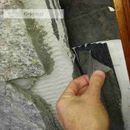Correct stucco/stone veneer wall assembly design question
I recently visited a job that had a wall assembly showing exterior veneer stone installed over cement scratch coat applied over metal lathe. My interest lay in the detail that followed, the metal lathe was installed over what looked like a polypropylene spun fabric that was applied over a corrugated barrier, looked like MTI’s Perforated Control Cavity but different, that was overlying 30# felt that was applied over standard Tyvek stapled to the plywood. Is this overkill? Couldn’t the Tyvek be eliminated? What is the purposed of the polypropylene fabric? Augment the drainage plane behind the stucco with a plane before and after the corrugated panel? Structural to augment the metal lathe to avoid cracking?
To increase the R-value of the same wall, if one were to apply 2 inches of rigid panel XPS directly over the plywood, could this same order be followed and eliminate the Tyvek as it would serve as the WRB? Setting up a metal lathe/stucco or stone veneer wall 2 1/2 inches away from the structural member of the wall concerns me. Despite the “outsulation” concept I don’t see it done. Even with longer fasteners spaced accordingly, does the weight moved so far away from the wall pose a possible weakness? Would it be wiser to use a lighter EIFS system in this situation? Thanks for any input/ constructive comments.
GBA Detail Library
A collection of one thousand construction details organized by climate and house part










Replies
Sal,
I'm guessing that the purpose of the polypropylene fabric was to prevent the scratch coat from filling the corrugations of the drainage material.
The builder or designer specified #30 felt over Tyvek because stone veneer jobs are associated with a high number of wet-wall disasters, and because many codes call for two layers of WRB for stucco and stone veneer jobs. If a builder or designer gets burned once because of a failure, the cost of the Tyvek is insignificant compared to the reduction in worries.
It's possible to use rigid foam as a WRB, but such an installation has to be carefully detailed if you want to get it right. For more information, see Using Rigid Foam As a Water-Resistive Barrier.
http://www.jpegmini.com/widget/cc0897c5-5fdf-40c5-9cb9-6d9a1acb1cac